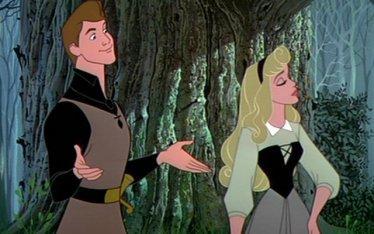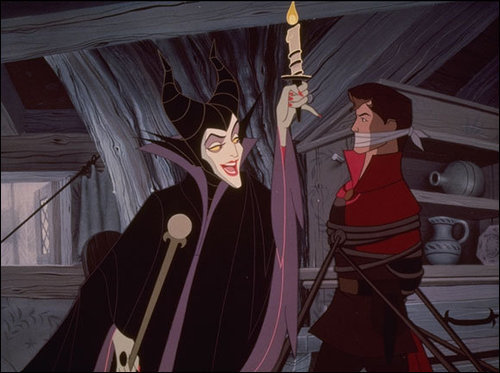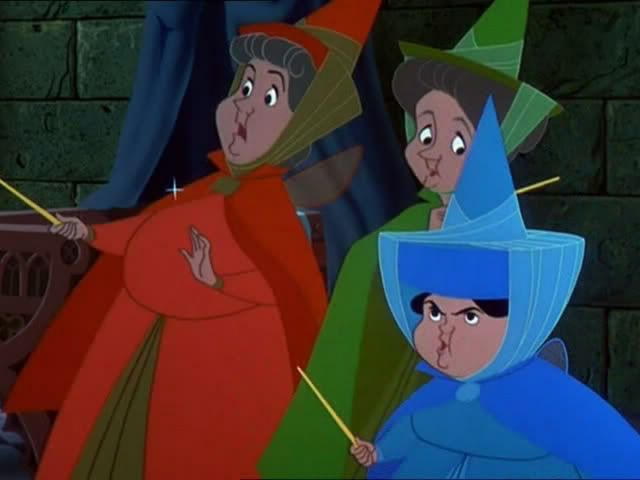By 1959, Disney’s take on lead female characters had improved somewhat, as evidenced by the women of the animated film Sleeping Beauty. Although the title character remains confined by roles deemed appropriate for women in the time period, she does represent a stronger, more opinionated woman than the docile and girlish Snow White. However, it is the supporting characters who most effectively break the gender stereotypes of the 1950s, demonstrating independence and power beyond even what is shown by the male lead and supposed hero of the film.
Despite the tendency to focus on male-dominated stories within the highly patriarchal society of the 1950s, the plot of Sleeping Beauty is driven by its female characters. The film opens at the birthday celebration of the infant Princess Aurora, where the three good fairies—Flora, Fauna, and Merryweather—are in the midst of offering gifts to the newborn. They are interrupted, however, by the appearance of the evil Maleficent, who places a deadly curse upon the baby in retaliation for her exclusion from the celebration. The good fairies’ third gift is then used to change the terms of the curse, allowing the child to be put into an enchanted sleep rather than being killed by the prick of a spindle on her sixteenth birthday.
The princess is then sent to be raised in secrecy by the three fairies, placing her into an all-female environment during her childhood years. Nearing her birthday, the princess happens unknowingly upon the prince to whom she is betrothed, and she falls in love with him. However, she is pained when she returns home and the fairies reveal her true identity and the plan to return her to the castle, as she believes that she will never see him again. When she returns on the eve of her birthday, Maleficent tricks her into touching the spindle of a spinning wheel, plunging her into the enchanted sleep. It is not until the prince battles Maleficent and kills her that he is able to reach Aurora, and she is awoken by his kiss.

Throughout the film, Aurora often behaves in a fashion that conforms to gender roles of the time period. "...Typical characteristics for women are piety, submissiveness, and domesticity" (gender stereotypes). She is seen as desirable for her gifts of beauty and song, and despite her isolation, these qualities attract the prince. Much like Snow White, Aurora falls in love with her prince mere moments after meeting him, and her desire to marry him is never questioned. However, while her decision to marry him is rushed and based on limited information, Aurora makes it clear that her voice matters in regard to her marriage. Unlike Snow White, who hopes only for a generic prince to find her, Aurora reacts with anger and sadness to the news that she is betrothed to Prince Phillip. She does not realize that the prince is the same man she met in the woods, and she is unwilling to give up her choice of a husband for someone—even a royal—who has already been chosen for her. Although this strength of will is weakened by Aurora’s enchanted sleep, which keeps her from being able to grant the prince consent when he kisses her and places him in a position of ultimate power, she still expresses her own opinions and decisions with more authority than Snow White.

While Prince Phillip is granted power over Princess Aurora through the enchanted sleep, the power balance of the overall film falls largely in the favor of female characters. Initially, her dark magic gives Maleficent power over Aurora, but this curse leads the prince to seek her out and destroy her in the end. However, the prince’s victory over Maleficent is made possible by the three good fairies, whose spells allow him to escape from her dungeon and give him the weapons he needs to keep himself alive and kill Maleficent. Flora, Fauna, and Merryweather do not physically engage in the battle, likely due to stereotypes marking women as nonaggressive and men as the heroes of battle, but they do cast the spells that keep the princess and the court safe, as well as spells that weaken Maleficent and protect and strengthen Phillip. Essentially, the final battle is a test of strength between the fairies and Maleficent, in which Phillip is a tool of their power rather than the all-conquering hero.

No comments:
Post a Comment